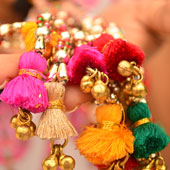There are various myths with regards to the origin of Parandi. Women in Punjab have always been fond of adorning themselves. According to Mr Neelam Kumar Khanna (Parandi manufacturer in Patiala), historically women wore Phulkari dupatta “odhini” to cover their heads, which was a societal requirement. In the process it would hide any hair accessory like a decorative clip or a pin. Therefore women came up with the idea of decorating the ends of their plait with beads, mirrors and ribbons. Soon this style became popular amongst masses leading to the design of long thread extensions that could be easily braided in hair and be seen even with the head covered.
Another story regarding the origin of the Parandi is to do with elderly women who were prone to lose hair at that stage in their life. They wanted to make their hair look longer and so they came up with the idea of a Parandi as an extension for their hair.
Not only the commoners but also the royalty, especially the maharani of Patiala got fond of the Parandi. To maintain their royal status, they added rich gold and multicolor threads to their Parandis. Mirrors, pearls, fancy ribbons were used further to enhance their royal look. Thus, Parandi became an important part of their dressing.
Young girls also got fond of Parandi who later added fancy tassels at the end. Soon Parandi was available in various patterns, designs and all possible colors to match their clothes.












